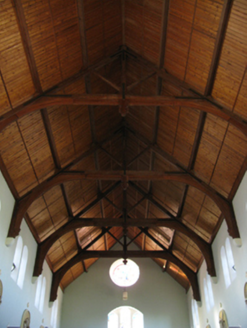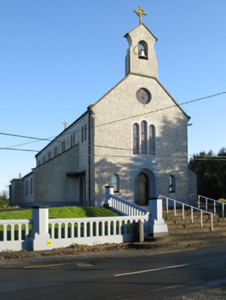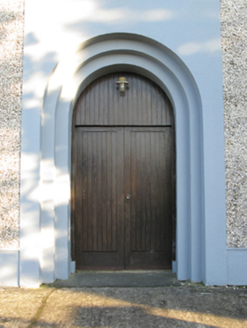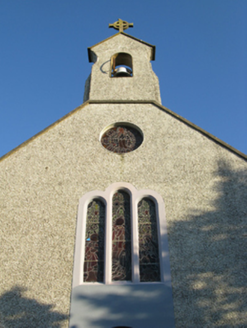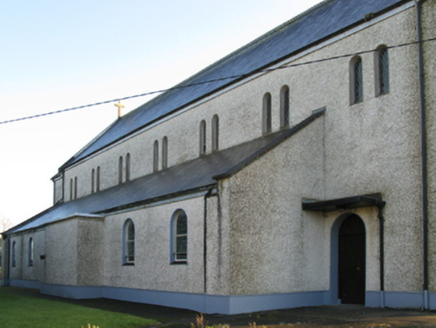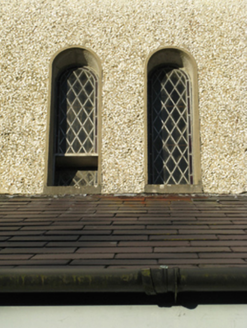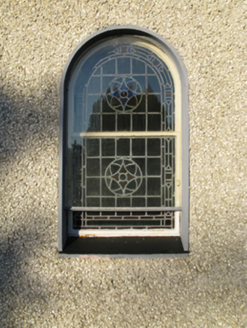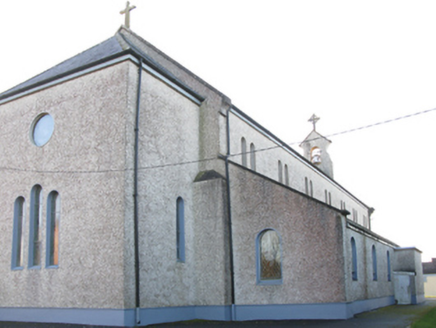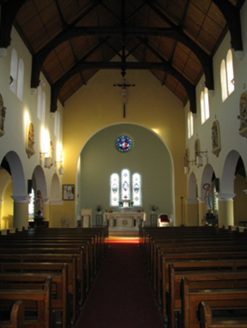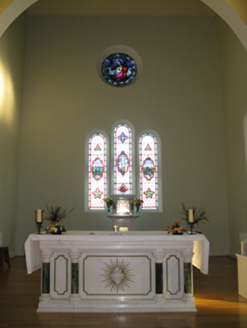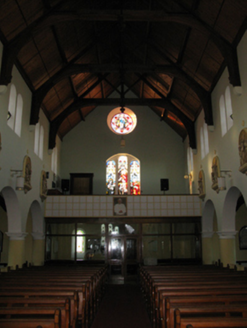Survey Data
Reg No
31309204
Rating
Regional
Categories of Special Interest
Architectural, Artistic, Historical, Social, Technical
Original Use
Church/chapel
In Use As
Church/chapel
Date
1930 - 1940
Coordinates
143958, 279412
Date Recorded
23/11/2010
Date Updated
--/--/--
Description
Detached eight-bay double-height Catholic church, built 1934-5; opened 1935; extant 1944, comprising seven-bay double-height nave opening into six-bay single-storey lean-to side aisles centred on single-bay double-height chancel (east). Renovated, 1968, with sanctuary reordered. Pitched slate roofs with lean-to slate roofs to side aisles, trefoil-perforated crested clay ridge tiles, lichen-covered concrete coping to gables on "Cavetto" kneelers including lichen-covered concrete coping to gable to entrance (west) front on "Cavetto" kneelers with gritdashed roughcast buttressed gabled bellcote to apex framing embossed cast-iron bell ("1887"), and cast-iron rainwater goods on rendered eaves retaining cast-iron downpipes. Gritdashed roughcast walls on rendered plinth. Paired round-headed window openings (clerestorey) with concealed dressings framing fixed-pane fittings having stained glass margins centred on lattice glazing bars. Round-headed window openings (side aisles) with concealed dressings framing storm glazing over fixed-pane fittings having leaded stained glass margins centred on leaded stained glass roundels. Round-headed "Trinity Window" to chancel (east) with concealed dressings framing storm glazing over fixed-pane fittings having leaded stained glass margins centred on leaded stained glass pierced ovals. "Rose Window" over with concealed dressings framing storm glazing over fixed-pane fitting having leaded stained glass margins centred on leaded stained glass panel. Round-headed door opening to entrance (west) front with rendered surround having stepped reveals framing timber boarded or tongue-and-groove timber panelled double doors having overpanel. Round-headed "Trinity Window" with rendered surround having chamfered reveals framing fixed-pane fittings having leaded stained glass panels. "Rose Window" to gable with concealed dressings framing fixed-pane fitting having stained glass margins centred on leaded stained glass octafoil. Interior including vestibule (west); square-headed door opening into nave with glazed timber double doors having overlight; full-height interior open into roof with choir gallery (west) below stained glass "Trinity Window" (????) and "Rose Window" (????), cut-veined white marble baptismal font on an octagonal plan, carpeted central aisle between timber pews, round-headed arcades on drum pillars, exposed split arch braced strutted collared timber roof construction on beaded corbels with wind braced timber boarded ceiling in carved timber frame on carved timber cornice, round-headed chancel arch framing stepped dais to sanctuary (east) reordered, 1968, with cut-veined white marble panelled altar below stained glass memorial "Trinity Window" (1934) and "Rose Window" (????), pair of cut-white marble Gothic-style wall monuments (ob. ????; ????) to side aisles, and exposed strutted timber roof construction with wind braced rafters to timber boarded ceiling. Set in landscaped grounds on a slightly elevated site.
Appraisal
A church erected under the aegis of, and to a design attributed to Reverend Charles J. White PP (????; cf. 31310206) representing an integral component of the early twentieth-century ecclesiastical heritage of County Mayo with the architectural value of the composition, one succeeding an adjacent chapel (1838) annotated as "New Catholic Chapel" on the first edition of the Ordnance Survey (surveyed 1838; published 1839), suggested by such traits as the rectilinear plan form, aligned along a liturgically-correct axis; the slender profile of the openings underpinning a streamlined Romanesque theme with the chancel defined by an understated "Trinity Window"; and the handsome bellcote embellishing the roofline as a picturesque eye-catcher in the landscape. Having been well maintained, the elementary form and massing survive intact together with substantial quantities of the original fabric, both to the exterior and to the interior reordered (1968) in accordance with the liturgical reforms sanctioned by the Second Ecumenical Council of the Vatican (1962-5) where wall monuments in a contrasting Gothic style; vibrant stained glass; and a jewel-like "Rose Window" recalling the Catholic Church of the Holy Rosary (1820; "improved" 1927), Glenisland (see 31306902), all highlight the artistic potential of the composition: meanwhile, an exposed timber roof construction pinpoints the engineering or technical dexterity of a church making an imposing visual statement in a sylvan setting.
